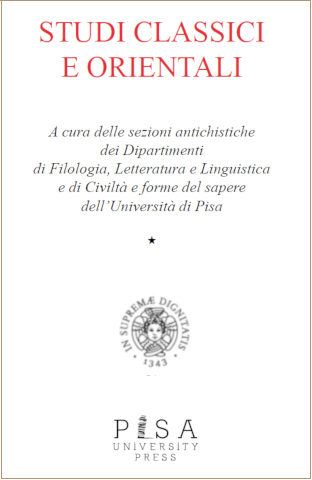Il monumento di Iasos per i basileîs di Caria
Abstract
The monument from Iasos for the basileîs of Caria.This paper presents the formal publication of the two remaining inscribedblocks belonging to the rectilinear base of a bronze dynastic group fromIasos. The monument has been already presented and discussed in otherseats. Of the two blocks, one is preserved in Iasos, the other in Istanbul.As for the first, it was brought to light by the Italian Archaeological Expeditionin Iasos in 2005. It had been reused during the imperial age in aroom of the West stoa of the agora. On the front is a fourth-century BCepigram honouring the basileis, the satrap Idrieus and another member ofthe Hecatomnid family, whose name had been erased.The second block lies in the garden of the Istanbul Archaeological Museums,where many inscriptions from Iasos were brought to in 1887. Itis the last on the right of a multipiece base, and a fourth-century inscriptionΑβα Υσσαλδωμου is carved on its front. The Museum inventoryregisters the block as ‘of unknown provenance’ (Istanbul inv. 3274),and as such it was published by L. Robert in Sinuri. He rightly recognizedin Aba an otherwise unknown sister of Hekatomnos, the father ofMaussollus and of the other satraps of the dynasty.Robert did not mention another inscription on the very damaged right shortside of the stone, an honorary inscription for a well-known athlete from Iasos, Ti. Flavius Metrobios, who won the dolichos in the first CapitolineGames (86 AD). The stone in Istanbul comes therefore from Iasos. Thesize, mouldings, and other details of the two blocks show that they originallybelonged to the same large monument in honour of the Hecatomnids.The paper consists of two parts. N. Masturzo illustrates, for the firsttime in detail, its monumental features. Different possible restitutionsof the monument, as a four or as a six statues group, are proposed.M. Nafissi revises his previous reading of the epigram carved on theblock in Iasos and offers an overview of the historical significance ofthe epigram and monument. The epigram is the first known contemporarydocument in Caria to call the Hecatomnids basileis. Its wordingseems to imply that the monument was placed in a cultic context. Aba’spresence on the monument strongly suggests that Hecatomnos marriedhis own sister, as Maussollus and Idrieus did later.
nmasturz@unito.it, massimo.nafissi@unipg.it
Fascicolo
Sezione
Articoli


